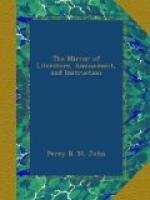The Indian corn being a large plant requires both air and space: it is consequently raised in hills far apart, after the manner of our hop plants; and reckons upon a deep ploughing between the hills after it is partly grown up for a supply of health and vigour. This great distance between the hills, sometimes placed four feet apart one way, and five feet apart another way, and the height of the plant with its lofty top and its lateral ears form a far different picture than that presented by an English corn field. Cobbett’s or the dwarf corn is, however, only four feet high: he planted his in rows three feet apart, which distance he is inclined to think is too small. “Three feet do not give room for good, true, and tolerably deep ploughing: and that is the main thing in the cultivation of corn, which indeed will not thrive well, if the ground be not deeply moved, and very near to the plants to which they are growing. You will see in America a field of corn late in June, perhaps, which has not been ploughed, looking to-day sickly and sallow. Look at it only in four days’ time, if ploughed the day after you saw it, and its colour is totally changed. Five feet are accordingly recommended as the distance between the rows, and six inches only between the plants.”
A great advantage of Indian or Cobbett’s corn is, that it occupies the ground for little more than half the year: it is planted in May or June, and ripens in November. Unlike common corn or grain, where there is generally a superabundance of blades, every plant of Indian corn is of importance: it cannot be spared; and as the sweetness of the early growth renders it a tempting prey to birds, insects, and rabbits, it becomes necessary to guard against their encroachments with the most lively care.




